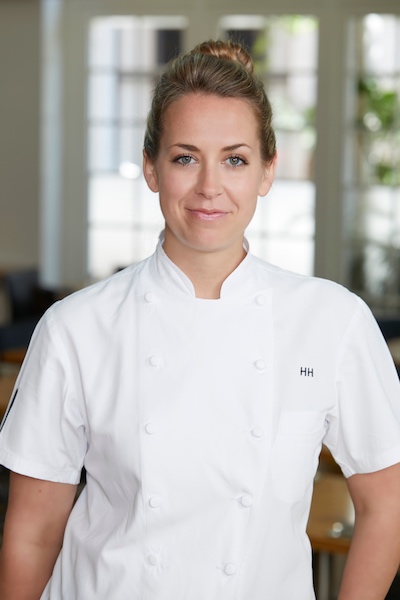Culinary Arts students study beef primals and fabrication during their introduction to the protein in Course 3. However, proper beef butchery techniques and best practices come with years of experience. For that, Hilary Henderson, chef de cuisine of CUT by Wolfgang Puck, shared her intimate knowledge from more than a decade in the kitchen of a fine-dining steakhouse at a virtual event in 2020.
Chef Hilary grew up in West Virginia where she experimented in the kitchen as a young child. Her curiosity led her to enroll in culinary school and after graduating, she landed at a French fine-dining restaurant in Pittsburgh as a line cook. Chef Hilary went on to intern at the historic Greenbrier in her home state before taking a position at Wolfgang Puck’s The Source in Washington, D.C. After proving herself, Chef Hilary was promoted to sous chef and then learned of an opportunity at CUT Los Angeles. She bought a one-way ticket to L.A. and after five years, she was promoted to chef de cuisine in 2016, earning the steakhouse a Michelin star in 2019.
 At a Zoom lecture and demonstration, Chef Hilary shared her best practices and showcased how to adeptly breakdown a subprimal strip loin. Here are her tips:
At a Zoom lecture and demonstration, Chef Hilary shared her best practices and showcased how to adeptly breakdown a subprimal strip loin. Here are her tips:
Find a Reliable Purveyor
“The key thing to working in a high-end, Michelin-starred steakhouse is consistency,” Chef Hilary says. “You have to be able to control what you can in a fast-paced, high-intensity environment. Controls are so important, so start with your relationships.”
Source Prime Beef
Beef is graded by the USDA with three levels: select, choice and prime, the highest grade possible. “Of the 90 million head of cattle a year, less than 3% are graded prime,” Chef Hilary says. “Prime will have more fat in the beef and that will give you that marbled texture.”
Try Bone-In Cuts
Bone-in steak is becoming a rare occurrence on menus, though it is a classic presentation. “The Kansas City steak is my favorite cut, based on flavor and texture – I’ll take it hands down any time,” Chef Hilary says. A bone-in ribeye, Kansas City steak is also called a Ridge Top or Cowboy Cut. There’s nothing more impressive to see than a Tomahawk, a ribeye with a long bone attached.
Feed Affects Flavor
“Corn-fed beef doesn’t make the meat taste like corn, it does however change the marbling,” Chef Hilary explains. “Grass-fed beef is much leaner.” What cattle eat affects the amount of fat, which impacts the flavor. “Think olive oil versus butter. You’re doing the same thing in the same capacity, but it results in different flavor profiles.”
Know the Difference Between Dry and Wet Aged
Wet aging meat is the process of sealing in a Cryovac and treating with oxygen. Dry aging beef is leaving the meat in a temperature and humidity-controlled environment, unencumbered. “Anything you’re going to buy and serve in a restaurant will be aged, if not it will be a super-tough product,” Chef Hilary says. The aging process breaks down the enzymes in the muscle, tenderizing it and adding flavor. “Think of it like a sauce reducing: Water is being wicked away so your flavors become more intense. Your fat is more condensed and your flavors start to change. You start to get this nice, nutty, little bit funky flavor and what you’re left with is a very tender, intensely flavored product.” Chef Hilary suggests that beef should be aged a minimum of 14 days with an ideal target of 30-35 days.
Follow Your Nose
“There are telltale signs if beef is unhealthy,” Chef Hilary says referring to how she judges product. “The bone should be white, the fat still yellow, but if it starts to turn green or blue or starts to look slimy, it's cultivated bad bacteria.” After assessing the meat visually, aroma is another cue. “The best indicator I can give you is that [good aged] beef smells nutty, like almonds or walnuts toasting in the oven, an intriguing smell,” she adds. “With enough experience, you can tell when something is not right — trust your gut on those things.”
Get hands-on experience with meat and other proteins in Culinary Arts at ICE.




